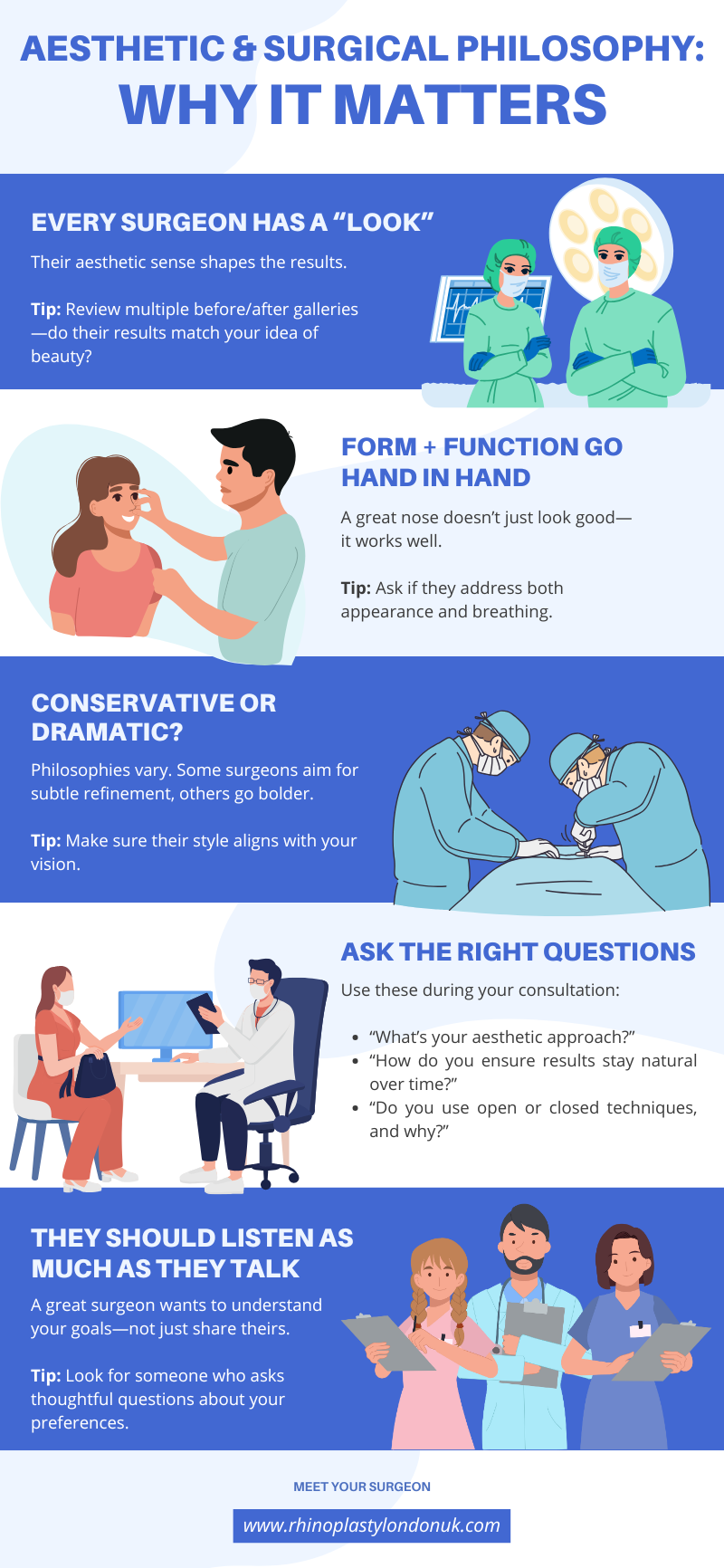Choosing a rhinoplasty surgeon is a big deal. It’s about finding someone who understands your vision and has the skills to bring it to life. With so many options out there, it can feel overwhelming.
But don’t worry! Here are seven key tips to help you make the right choice for your rhinoplasty journey.
Key Takeaways
- Always check that your rhinoplasty surgeon is board certified.
- Look for experience specifically in rhinoplasty procedures.
- Make sure their aesthetic philosophy aligns with your vision.
- Review their portfolio for quality before-and-after photos.
- Read patient reviews to gauge satisfaction and outcomes.
1. Board Certification and Surgeon’s Credentials

Choosing the right surgeon for your rhinoplasty starts with checking their credentials. You want someone who’s not just qualified, but also dedicated to providing the best possible care.
Board certification is a key indicator of a surgeon’s expertise and commitment to high standards. It means they’ve undergone extensive training and have been rigorously assessed.
Here’s what to look for:
- Board Certification: Make sure you chose a board-certified surgeon in a relevant specialty like Otolaryngology (Head and Neck Surgery) or Plastic Surgery. This shows they’ve met specific educational and training requirements.
- Specialised Training: Look for surgeons with specific training in facial plastic surgery, particularly rhinoplasty. A general surgeon might not have the nuanced skills needed for this delicate procedure.
- Professional Memberships: Membership in professional organisations like the British Association of Plastic, Reconstructive and Aesthetic Surgeons (BAPRAS) can be a good sign. These organisations often have strict membership criteria.
It’s always a good idea to double-check a surgeon’s credentials with the relevant medical boards. This ensures their certification is current and valid. Don’t be afraid to ask for proof – it’s your right to know!
2. Experience and Specialisation
Let’s talk about something just as important: how much actual experience they’ve got under their belt. It’s not just about how long they’ve been a surgeon, but what they’ve been doing with that time.
You want someone who’s not just done a few nose jobs here and there, but someone who lives and breathes rhinoplasty.
Understanding Surgeon’s Experience
Experience really does matter. A surgeon who’s performed loads of rhinoplasties is likely to be more skilled. They’ve seen it all, dealt with different challenges, and know how to handle unexpected situations.
It’s not just about the years they’ve been practising, but the depth of their experience.
- Have they tackled a wide range of cases?
- Do they seem confident when discussing complex scenarios?
Assessing Procedure Frequency
How often does the surgeon actually perform rhinoplasty? This is a big one.
A surgeon who regularly performs these procedures is going to be more up-to-date with the latest techniques and better at anticipating results. High case volumes often mean a strong dedication to nasal aesthetics and functional outcomes.
It’s a good sign if they regularly do both primary and revision rhinoplasty – that shows they’re comfortable handling all sorts of situations.
Specialisation Matters
Does the surgeon specialise in rhinoplasty, or is it just one of many procedures they offer? Ideally, you want someone who focuses primarily on facial plastic surgery, and even better, someone who has a particular interest in noses.
A specialist is more likely to have a deeper understanding of nasal anatomy and the nuances of rhinoplasty techniques. They’ll also be more aware of the latest advancements in the field.
It’s worth remembering that rhinoplasty isn’t a one-size-fits-all procedure. Noses come in all shapes and sizes, and what works for one person might not work for another. A surgeon with plenty of experience and specialisation will be able to tailor the procedure to your specific needs and goals.
Ask about their experience, how often they perform rhinoplasty, and whether they have any particular areas of specialisation. It could make all the difference to your result.
3. Aesthetic and Surgical Philosophy

Now, it’s time to get a feel for their artistic side. This is where you figure out if their vision matches what you’re hoping to achieve.
Understanding the Surgeon’s Approach
Every surgeon has a slightly different way of doing things. Some are all about making subtle, natural-looking changes, while others might be more comfortable with dramatic transformations. It’s important to understand their general philosophy.
Ask them questions like:
- “Do you prefer open or closed rhinoplasty techniques, and why?”
- “How do you balance aesthetic goals with functional needs (like breathing)?”
- “Can you describe your approach to creating a natural-looking result?”
Aligning Expectations
This is where you really need to be on the same page. Bring photos of noses you like (and, just as importantly, noses you don’t like). Talk openly about what you’re hoping to achieve. A good surgeon will be honest about what’s realistic and what isn’t.
It’s a two-way street. You need to understand their style, and they need to understand your goals. If there’s a disconnect, it might be a sign to keep looking.
Considering Ethnic Background
Rhinoplasty isn’t a one-size-fits-all procedure. A skilled surgeon will take into account your ethnic background and facial features to create a result that looks harmonious and natural. They should be able to explain how they approach rhinoplasty in a way that respects your unique identity.
4. Quality of the Surgeon’s Portfolio
Don’t skip this part. Looking at a surgeon’s portfolio is like window shopping – you get a real feel for their style and skill. It’s all about the before-and-after photos.
- Does the surgeon have a good range of cases? You want to see they’ve worked with different nose shapes and sizes.
- Are the results natural-looking? This is key. You don’t want a nose that looks ‘done’.
- Do the ‘after’ photos look consistently good? Or are there some that look a bit…off?
I remember when I was looking at portfolios, I was really focusing on whether the results looked natural and suited the person’s face. It’s easy to get caught up in wanting a ‘perfect’ nose, but what really matters is that it looks good on you.
Basically, you’re trying to get a sense of the surgeon’s aesthetic.
- Do they have an eye for detail?
- Do they understand facial harmony?
A good portfolio will give you confidence that they can deliver the results you’re hoping for.
5. Patient Reviews and Testimonials
Looking at patient reviews and testimonials is like getting the inside scoop on a surgeon. It’s not just about the star ratings; it’s about digging into the details.
Reading Through Patient Feedback
Patient reviews can give you a real sense of what to expect. Sure, everyone’s experience is different, but consistent themes will start to emerge.
- Are patients consistently happy with the aftercare?
- Do they feel heard and understood by the surgeon?
These are the things you want to know. Don’t just glance at the five-star reviews; read the actual comments. Look for specifics.
- Did the surgeon address their concerns properly?
- Was the team supportive during recovery?
Analysing Patient Satisfaction
So, you’ve found a bunch of reviews. Now what? Look for patterns. A surgeon with consistently positive feedback is usually a good sign.
Here’s what to keep an eye out for:
- Attention to detail: Did the surgeon really listen to what the patient wanted?
- Post-operative support: Was there good aftercare?
- Overall satisfaction: Are people happy with the results?
It’s worth remembering that everyone heals differently, and not every surgery goes perfectly. But a good surgeon will be upfront about potential risks and complications, and they’ll be there to support you if things don’t go exactly as planned.
Basically, patient reviews are your chance to do some proper detective work. Don’t skip this step!
6. Consultation Process and Communication
Choosing a surgeon isn’t just about qualifications; it’s about finding someone you trust and feel comfortable with. The consultation process is where you really get a feel for that. It’s your chance to ask all those burning questions and see if the surgeon is truly listening.
What to Expect During Your Consultation
You’re there to assess the surgeon just as much as they’re assessing you. They should take the time to understand your goals, examine your nose, and explain what’s realistically achievable. If they rush you or don’t seem interested in your concerns, that’s a red flag.
Asking the Right Questions
Come prepared with a list of questions. Seriously, write them down! It’s easy to forget things when you’re nervous.
Here are a few to get you started:
- What are the potential risks and complications?
- How many rhinoplasty procedures have you performed?
- Can I see before-and-after photos of patients with similar nasal structures to mine?
- What is your approach to achieving a natural-looking result?
Gauging Communication Style
Good communication is key. The surgeon should explain things in a way you understand, without using complicated medical jargon. They should also be open and honest about the potential downsides of the surgery.
If they promise you perfection or avoid answering your questions directly, be wary.
A good surgeon will not only explain the procedure in detail but also take the time to listen to your concerns and address them with empathy and understanding. They should make you feel confident and informed every step of the way.
The Importance of a Good Rapport
Ultimately, you need to feel a connection with your surgeon.
- Do you feel comfortable talking to them?
- Do they seem genuinely interested in helping you achieve your goals?
If the answer is no, it might be worth looking elsewhere. Trust your gut – it’s usually right.
7. Location and Accessibility of the Surgeon
Choosing a surgeon close to home might seem like a small thing, but it can make a big difference in your overall experience. Think about it: you’ll need to attend several appointments before and after the rhinoplasty procedure.
The closer your surgeon, the easier and less stressful these visits will be.
Travel Considerations
If you’re considering a surgeon who isn’t local, factor in the costs and time associated with travel.
This includes:
- Transportation costs (flights, trains, petrol).
- Accommodation expenses if overnight stays are needed.
- Time off work for appointments and the surgery itself.
- Potential for delays or disruptions to your travel plans.
Post-Operative Care
Post-operative care is a really important part of any surgery. Regular check-ups are needed to make sure everything is healing as it should. If you live far away, attending these appointments can become a real hassle.
It’s worth thinking about how easy it will be to get to your surgeon for those follow-up visits.
Emergency Situations
While complications are rare, it’s reassuring to know that your surgeon is easily accessible should any issues arise after the surgery. Having a surgeon nearby can provide peace of mind and facilitate prompt attention if needed.
Choosing a surgeon is a big decision, and location is just one piece of the puzzle. Don’t let it be the only factor, but definitely consider how it will impact your overall experience. A local surgeon can make the whole process smoother and less stressful, especially when it comes to follow-up care and any unexpected issues.
Conclusion
Picking the right surgeon for your rhinoplasty is a big deal. It can really shape your experience and the results you get. Take your time to do your homework. Look into their qualifications, check out reviews, and don’t hesitate to ask questions during your consultations.
Remember, it’s about finding someone who understands what you want and can guide you through the process. Many surgeons offer a free initial consultation—not only is it a chance to explore your options, but it often reflects their confidence in their skills and ability to deliver results. With the right surgeon by your side, you can feel more confident about your decision and look forward to the results.
Frequently Asked Questions
What should I look for in a rhinoplasty surgeon?
It’s important to check if the surgeon is board-certified and has experience in rhinoplasty. Look for someone who has specialised training in nose surgeries.
How do I know if a surgeon is experienced?
You can find out about a surgeon’s experience by looking at their portfolio of past work, checking their reviews, and asking how many rhinoplasties they have performed.
What is the consultation process like?
During the consultation, you’ll discuss your goals and expectations. The surgeon should explain their approach and answer any questions you have about the procedure.
How can I find reviews for rhinoplasty surgeons?
You can search online for reviews on medical websites, social media, or ask for recommendations from friends or family who have had similar procedures.
Why is the surgeon's philosophy important?
Understanding a surgeon’s aesthetic and surgical philosophy helps ensure that their approach aligns with your goals for the rhinoplasty.
How does location affect my choice of surgeon?
Choosing a surgeon close to your home can make follow-up appointments easier and reduce travel costs, which is important for your recovery.





